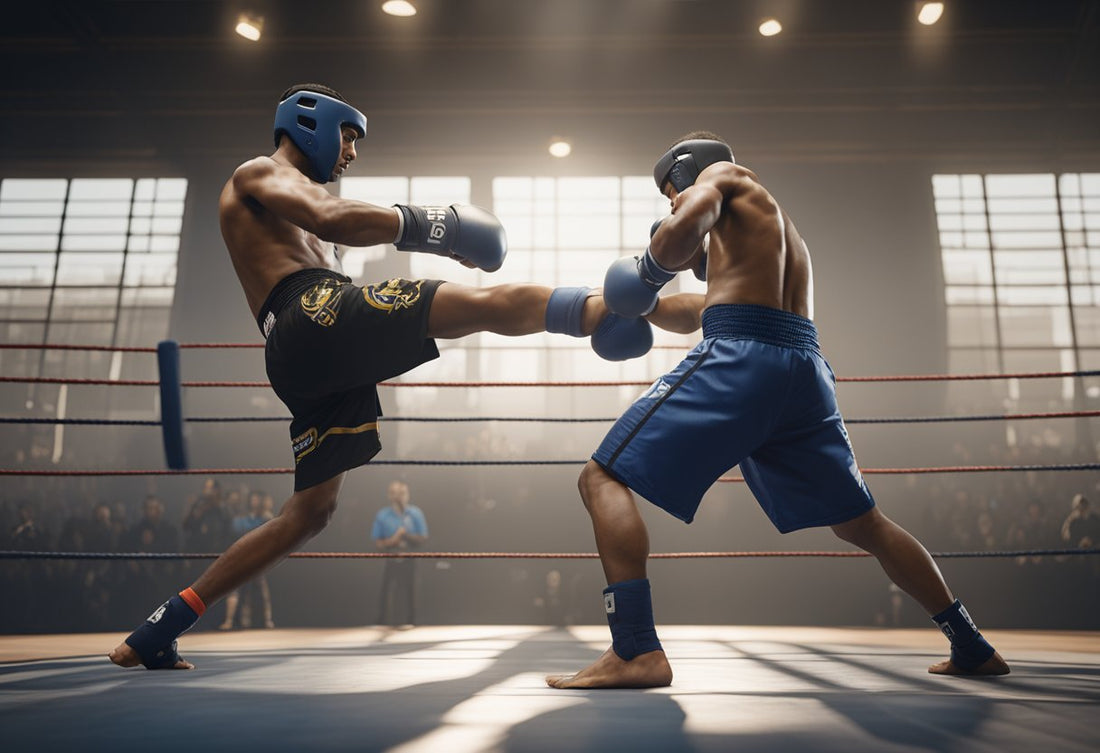
K1 or BJJ: Striking vs Grappling
Share
When it comes to martial arts, there are a variety of styles to choose from. Two popular styles are grappling and striking. Grappling involves close contact fighting, where the goal is to gain control over your opponent through holds, locks and submissions. Brazilian Jiu-Jitsu (BJJ) is a popular form of grappling, which focuses on ground fighting and submission holds. Striking, on the other hand, involves using punches, kicks, and other strikes to attack your opponent from a distance. K1 kickboxing is a popular form of striking, which combines techniques from boxing, karate, and Muay Thai.

Both grappling and striking have their advantages and disadvantages. Grappling can be very effective in close-quarters combat, where you need to take your opponent down and control them on the ground. However, it can be difficult to use grappling techniques against multiple opponents or in situations where you need to keep your distance. Striking, on the other hand, can be very effective in situations where you need to keep your distance from your opponent, or when you are facing multiple opponents. However, striking can be less effective against opponents who are skilled at grappling, as they can close the distance and take you down to the ground.
If you are interested in martial arts and are trying to decide between grappling and striking, it is important to consider your goals and the situations in which you are likely to use your skills. If you are interested in self-defence, grappling may be a good choice, as it can be very effective in close-quarters combat. However, if you are interested in competition fighting, striking may be a better choice, as it can be more effective in a ring or cage. Ultimately, the choice between grappling and striking will depend on your personal preferences and goals.
Understanding Grappling and Striking

When it comes to martial arts, grappling and striking are two of the most common techniques used in combat. Grappling involves controlling your opponent using techniques such as takedowns, joint locks, and submissions, while striking involves hitting your opponent with punches, kicks, elbows, and knees.
One of the main differences between grappling and striking is the focus of each technique. Grappling is more focused on control and submission, while striking is more focused on force and impact. Grappling is often used in ground fighting, while striking is more commonly used in stand-up fighting.
In grappling, the goal is to dominate your opponent by controlling them and putting them in positions where they are vulnerable to submission techniques such as chokes and joint locks. In striking, the goal is to use your speed, power, and technique to strike your opponent and score points or knock them out.
Both grappling and striking have their advantages and limitations. Grappling is particularly useful in self-defense situations, where controlling your opponent and taking them to the ground can give you an advantage. Striking is more effective in situations where you need to keep your distance from your opponent and use your speed and technique to strike from a distance.
In summary, grappling and striking are two different fighting styles that require different techniques and strategies. Whether you choose to focus on grappling or striking, it's important to understand the strengths and limitations of each technique and to develop a well-rounded approach to martial arts.
Exploring K1 Kickboxing

K1 kickboxing is a form of kickboxing that originated in Japan in the early 1990s. It is a full-contact sport that allows the use of punches, kicks, and knees. The rules of K1 kickboxing are different from other forms of kickboxing, such as Muay Thai or American kickboxing. In K1 kickboxing, fighters wear shorts and boxing gloves, and they fight in a ring.
One of the main differences between K1 kickboxing and other forms of kickboxing is the stance that fighters use. In K1 kickboxing, fighters use a more squared stance, which allows them to throw powerful punches and kicks. This stance also allows fighters to defend themselves better against takedowns and grappling techniques.
Knees are also a significant part of K1 kickboxing. Fighters are allowed to use their knees to strike their opponents, which can be a devastating weapon. Knees are especially effective when used in close range, as they can generate a lot of force and cause significant damage.
K1 kickboxing is known for its fast-paced and exciting fights. Fighters need to have excellent stamina to compete in K1 kickboxing, as the fights can last for several rounds. The sport also requires a lot of power and precision, as fighters need to be able to land their strikes accurately and with force.
Overall, K1 kickboxing is a dynamic and challenging sport that requires a lot of skill and athleticism. If you are interested in learning more about K1 kickboxing, you can watch videos of fights online or try sparring with a partner to get a feel for the sport.
Delving into Brazilian Jiu-Jitsu

Brazilian Jiu-Jitsu (BJJ) is a martial art that focuses on grappling techniques and submissions. It originated in Brazil in the early 20th century and has since become one of the most popular martial arts in the world.
One of the advantages of BJJ is its focus on leverage and technique over strength and size. BJJ practitioners learn to use their opponent's weight and momentum against them, making it possible for smaller individuals to dominate larger opponents.
BJJ is typically practiced in a gi, a traditional uniform that includes a jacket and pants. The gi allows for a wider range of techniques, including chokes and joint locks that can be difficult to execute without the added friction of the fabric.
However, BJJ can also be practiced without a gi, known as no-gi grappling. In no-gi grappling, practitioners wear rash guards and shorts to minimize friction and allow for faster movements.
BJJ techniques are heavily influenced by Judo and wrestling, with a focus on takedowns and ground control. BJJ practitioners use hooks and other techniques to control their opponent's movements and set up submissions.
BJJ also uses a belt system to signify rank and progression. The belts, from white to black, signify increasing levels of skill and knowledge.
Overall, BJJ is a highly effective martial art for self-defense and competition. Its focus on technique and leverage make it possible for smaller individuals to dominate larger opponents, and its emphasis on submissions makes it a formidable force in grappling martial arts.
Comparing K1 Kickboxing and Brazilian Jiu-Jitsu
If you are looking for a comparison between K1 Kickboxing and Brazilian Jiu-Jitsu, you have come to the right place. These two martial arts are very different from each other, and they each have their own strengths and weaknesses.
K1 Kickboxing is a striking martial art that focuses on using punches, kicks, knees, and elbows to defeat your opponent. It is a very powerful martial art that requires a lot of force and speed to be effective. The stance of a K1 Kickboxer is very important, as it enables them to generate the most power possible in their strikes.
Brazilian Jiu-Jitsu, on the other hand, is a grappling martial art that is all about submitting your opponent on the ground. It is a very strategic martial art that requires a lot of technique and stamina to be effective. The goal of Brazilian Jiu-Jitsu is to dominate your opponent and force them to submit.
In mixed martial arts (MMA), both K1 Kickboxing and Brazilian Jiu-Jitsu are used together to create a complete fighting style. K1 Kickboxing is used for striking, while Brazilian Jiu-Jitsu is used for grappling. This combination of fighting styles is very effective, as it allows fighters to be prepared for any situation.
One of the main differences between K1 Kickboxing and Brazilian Jiu-Jitsu is their limitations. K1 Kickboxing is very effective against a single attacker, but it can be difficult to use against multiple attackers. Brazilian Jiu-Jitsu, on the other hand, is very effective against multiple attackers, but it can be difficult to learn.
Another difference between the two martial arts is the gear that is used. K1 Kickboxers wear gloves and shin guards to protect their hands and feet, while Brazilian Jiu-Jitsu practitioners wear a gi (a special type of uniform) to allow for better grip and control on the ground.
In conclusion, K1 Kickboxing and Brazilian Jiu-Jitsu are two very different martial arts that each have their own strengths and weaknesses. While K1 Kickboxing is all about striking with force and speed, Brazilian Jiu-Jitsu is all about dominating your opponent on the ground. In MMA, both martial arts are used together to create a complete fighting style that is effective in any situation.
Conclusion
So, what is the best martial art for self-defense? The answer is not so simple and depends on your personal preferences, physical abilities, and the situation you might find yourself in.
If you are looking to defend yourself against multiple attackers, striking martial arts such as K1 kickboxing might be more suitable for you. They allow you to keep a safe distance from your opponents and strike them from a distance. However, if you are facing a single opponent, grappling martial arts like Brazilian Jiu Jitsu might be more effective. They allow you to control your opponent on the ground and submit them.
In general, both grappling and striking martial arts have their pros and cons. Grappling is excellent for one-on-one fights, but less effective against multiple attackers. Striking is better suited for multiple attackers, but has limited use on the ground.
Ultimately, the best self-defense strategy is to have a well-rounded skill set that includes both grappling and striking techniques. This will give you the flexibility to adapt to any situation and defend yourself effectively.
